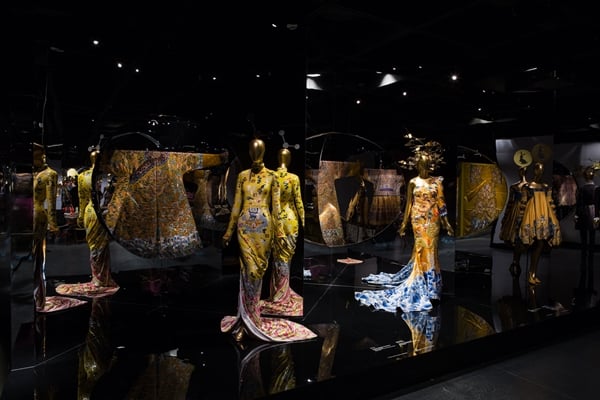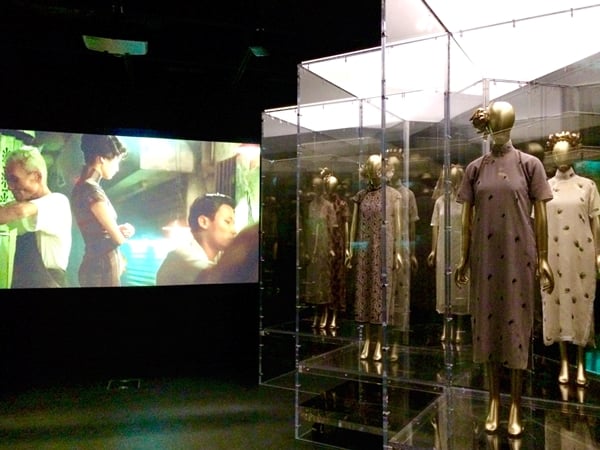Art & Exhibitions
See Highlights of the Met Costume Institute’s Dramatic New China Exhibition
Find a 21st century couture dress juxtaposed with an 18th century snuff bottle.
Find a 21st century couture dress juxtaposed with an 18th century snuff bottle.
Christie Chu

This year’s Metropolitan Costume Institute exhibition, “China: Through the Looking Glass,” is a big deal—literally. With over 140 items of haute couture, all of the museum’s Chinese galleries have been occupied, along with the Anna Wintour Costume Center, making the total exhibition space 30,000 square feet—almost three times the size of their usual spring shows. The sprawling show, curated by the Costume Institute’s Andrew Bolton and artistically directed by cinema maestro Wong Kar-wai, illustrates how Chinese culture has influenced Western fashion and demonstrates how much can be achieved from cross-cultural collaboration (see See 25 Images of The Glamorous Metropolitan Museum Costume Institute Gala 2015).
The show is organized into various thematically arranged rooms, across several of the museum’s floors, what Bolton describes as “film stills.” Each exhibition room is divided into sub-categories, such as “Saint Laurent & Opium,” which features the fashion of Yves Saint Laurent, whose Mongol-inspired collection (on view in the rooms) coincided with the controversial launch of his perfume, Opium, in the 1970s.
In another room, with a blue porcelain theme, several haute couture dresses seem inspired by the ceramics on view, including a Li Xiaofeng dress—possibly the only thing in the exhibition that you couldn’t wear—composed of shards of porcelain.

Li Xiaofeng, The Weight of the Millenium (2015).
Photo: Christie Chu.
Wong Kar-wai successfully creates the mood one would expect from the director of In the Mood for Love, incorporating into the settings film clips and appropriately dim lighting (see Wong Kar-wai Will Director Met Show on Chinese Influence in Fashion). Walking through the show, the viewer is immersed into Wong’s sensual world. From the red lanterns lining the stairways to the lacquered display platforms, the filmmaker effortlessly gets museum-goers in the mood to be seduced by the show.
While the exhibition is something of a whirlwind, the overall concept is a triumph: It pairs one-of-a-kind garments from celebrated designers such as Karl Lagerfeld, Alexander McQueen, and Valentino with antique Chinese art objects.
In the Anna Wintour Costume galleries, 18th-century Manchu robes, once worn by imperial emperors and a sartorial signifier of power and wealth, hang in mirrored round glass cases at the periphery of the rooms. Nearby, works by contemporary designers—body-accentuating silhouettes, embroidered bodices and jackets by the likes of Tom Ford, Laurence Xu, and Dries Van Noten—are draped on mannequins peppered across the floor space. Especially stunning was the 2004 yellow gown by Ford for Yves Saint Laurent.

Installation view.
Photo: courtesy of the Metropolitan Museum of Art.
Some might complain that the show perpetuates stereotypes and indulges in cultural appropriation without sufficiently exploring it, but that appears to be the point. This show is a stage for fantasy, imagination, and conversation, not cultural critique.
A room dedicated to calligraphy—the most respected form of artistic expression in China—features two 1950s silk numbers, one by Coco Chanel, the other by Christian Dior, juxtaposed with 19th-century Imperial scrolls and a film clip of Zhang Yimou’s 2002 hit Hero. The multimedia approach enables the exhibition to have a certain dynamism where different power relationships are presented, though not explained.
For instance, the historical consequences of the Opium Wars are introduced with a clip of the 1919 film Broken Blossoms, where the film’s protagonist, a Chinese immigrant, travels to London in the hopes of spreading Buddhism, but struggles in the foreign city and becomes addicted to the drug. Here we see a window open for a bigger conversation. But it is quickly closed by the interrupting loop of other films that depict the use of Opium, such as Once Upon a Time in America starring Robert de Niro. The film clips, in other words, are employed to help the viewer imagine a different time and place rather than think about the cross-cultural power relationships at play.

Installation shot.
Photo: Christie Chu
The history of trade is addressed in the “Export Silk” room, which includes a quietly chic floral dress by Cristobal Balenciaga placed among early 20th-century Chinese shawls; femininity is the topic in a room dedicated to the significance of the qipao (the traditional Chinese dress) juxtaposed with films such as Wong’s own In the Mood for Love and Ang Lee’s Lust, Caution; and politics rules in a space dedicated to the Mao suit which features two Vivienne Tam outfits printed with Chinese artist Zhang Hongtu’s Andy Warhol-esque Mao imagery. Again, any attempt to try and read the show as more than simply a visual feast for hungry eyes fails. But it remains visually stunning, at once serious, playful, mysterious, and enlightening.
Perhaps American visitors will leave the show ready to binge-watch The Grandmaster or The Last Emperor. Chinese museum-goers may leave with a new found appreciation for wearing a traditional qipao instead of opting for the latest Western fashions. Either way, the show provides a much-needed and timely platform to at least start, if not fully engage in, a cross-cultural dialogue.
“China: Through the Looking Glass” is on view May 7 through August 16, 2015.